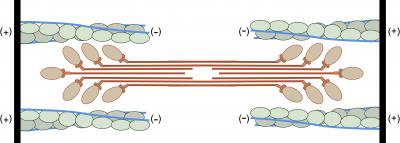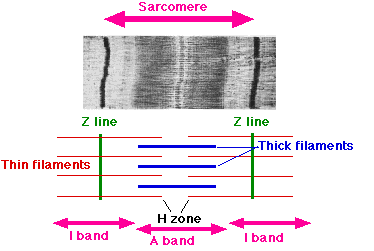Sarcomere
Online Biology Dictionary Video: The Sarcomere - Structure and Components|
|
EUGENE M. MCCARTHY, PHD GENETICS

| |
|
Schematic: The Z line is depicted in black, myosin in red, actin in green/gray, and tropomyosin in blue. Image: MPI of Molecular Plant Physiology | |

|
The sarcomere is the fundamental unit of muscle structure. Its capacity for contraction is the essential trait that makes muscles work. It has two primary components (1) thin filaments (each of which contains two strands of actin and a single strand of regulatory protein); and (2) thick filaments made of myosin (see diagram right).
Sarcomere and myocyte
A skeletal muscle is composed of bundles of extremely lengthy cells (myocytes or myofibers), which are circular in cross-section and as long as the muscle itself (picture). Each such cell contains a bundle of myofibrils, linear organelles that are themselves composed of multiple strands that are long sarcomeric chains (picture).
The A band is the region where thick filaments are present, but the H zone is the region where only thick filaments are present (see video above). The think filaments are composed of myosin. So the A band represents the whole length, or ALL, of the myosin filament, which is composed of interwoven myosin molcules. Each myosin molecule within the myosin filament has a head and a tail. The heads are the bulbous elements that can be seen in the illustration.
The I bands are the two regions where thin filaments exclusively are present. The Z lines, or Z disks, which have a jagged appearance under a microscope, are the boundaries between adjacent sarcomeres. The I bands span on either side of the Z-disks and represents the region between the ends of the thick filaments, that is, between the A bands. In the I bands only actin is found (so remember the i in actin).
The division lying half way between the Z lines is known as the M line, where M stands for "middle." The M line corresponds to the region where strands of a protein called myomesin are found. So you could also think of the M in M-line, too, as standing for "myomesin."
During muscle contraction the thick filaments quickly slide along the thin filaments to shorten the myofibrils. The myofilaments themselves, however, do not contract. This is the action that give muscles their physical force.
| Etymology: The prefix sarco- is from the Greek word sarx, meaning flesh, and in biological terminology usually refers to muscle tissue. The suffix -mere is from the Greek word meros, meaning share, portion, or part. Some other common bio terms based on the same word parts are: sarcoma and telomere. |